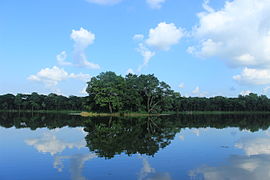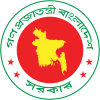Barisal
Barisal বরিশাল Barishal | |
|---|---|
City | |
      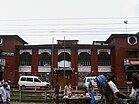  From top: City skyline, Guthia Mosque, Durga Sagar lake, Oxford Mission Church, Brojomohun College, Bell's Park aka Bangabandhu Udyan, Barisal Town hall and Kirtonkhola River port | |
| Nickname(s): Venice of the East | |
 Barisal Location of Barisal in Bangladesh | |
| Coordinates: 22°48′0″N 90°30′0″E / 22.80000°N 90.50000°E / 22.80000; 90.50000 | |
| Country | Bangladesh |
| Division | Barisal Division |
| District | Barisal District |
| Municipality Eshtablished | 1876 (1876) |
| City Corporation | 2002 (2002) |
| Granted city status | 19 April 2001[1] |
| Government | |
| • Type | Mayor–Council |
| • Body | Barisal City Corporation |
| Area [2] | |
| • Urban | 58 km2 (22 sq mi) |
| Elevation | 1 m (4 ft) |
| Population (2011)[3] | |
| • City | 328,278 |
| • Density | 10,524/km2 (27,260/sq mi) |
| • Metro | 385,093 |
| Time zone | UTC+6 (BST) |
| Postal code | 8200 |
| Calling code | 0431 |
| National calling code | +880 |
| Police | Barisal Metropolitan Police |
| Domestic airport | Barisal Airport |
| Website | Official Web Portal |
Barisal, officially known as Barishal,[4] (Bengali: বরিশাল Bengali Pron: [boɾiʃal]) is a major city that lies on the bank of Kirtankhola river in south-central Bangladesh. It is the largest city and the administrative headquarter of both Barisal district and Barisal Division. It is one of the oldest municipalities and river ports of the country. Barisal municipality was established in the year 1876 during the British Raj and upgraded to City Corporation on 25 July 2002.[5] The city consists of 30 wards and 50 mahallas with a population of 328,278 according to the 2011 national census. The area of the city is 58 km².[6]
Contents
1 History
2 Population
2.1 Demographics
2.2 Languages
2.3 Religion
3 Geography
4 Climate
5 Economy
6 Points of interest
7 Architecture
8 Sports
9 Transport
9.1 Air
9.2 River port
9.3 Road
10 Education
11 Culture
11.1 Media
11.1.1 Newspapers
11.1.2 Periodicals
12 Notable people
12.1 Science and academia
12.2 Sports and athletics
13 See also
14 References
15 External links
History
Barisal was a semi-independent area in the Mughal period because of heavy fighting between them and Hindu chiefs. In course of time, it fell under the Bengal Nawabs, the last being Raja Ramranjan Chakravarty and then colonial British India, later passed to East Pakistan at independence and finally Bangladesh.
The ancient city of Barisal was known as Bacola in Europe. Ralph Fitch, the first ever Englishman, a leather merchant, known to have visited Bengal in the mid 1580s, described Barisal in his journal as, “From Chatigan in Bengal, I came to Bacola; the king whereof is a Gentile, a man very well disposed and delighted much to shoot in a gun. His country is very great and fruitful, and hath store of rice, much cotton cloth, and cloth of silk. The houses are very fair and high built, the streets large, and people naked, except a little cloth about their waist. The women wear a great store of silver hoops about their necks and arms, and their legs are ringed with silver and copper, and rings made from elephants’ teeth.”[7]
The central city of this region is the city of Barisal. It is one of the biggest river ports in Bangladesh. It is a city with nearly 0.38 million people and a divisional headquarters, medical college, cadet college, some pharmaceutical industries, textile industries and the Bangladesh Inland Water Transport Authority's head office. Barisal is fast growing city of the country stands on the Kirtankhola River. Country's first short landing and take off airport has been completed in Barisal and a private Airlines named Air Bengal has begun its regular air flight between Dhaka Hazrat Shahjalal Airport and Barisal.
The city is called the "Venice of the East" or the "Venice of Bengal"[8] and the "Paradise of Bengal". "Barisal guns" is a natural phenomenon named after Barisal; it is kind of a booming sound heard near lakes and rivers which is due to seismic activity under water, first heard in this region by the British in the 19th century.
Population
Demographics
According to provisional results of the 2011 national census, the population of Barisal (areas under the jurisdiction of the Barisal city corporation) stands at 328,278.[3] By gender, the population was 51.63 male and 48.37 percent female.[6]
The literacy rate among the urban people of Barisal is 75.3%.[9] which is significantly higher than the national average of 56.5%.
Most of the people in Barisal are the Bengali people, as is the case in most of Bangladesh. The long-standing inhabitants of the city are known as Barisaliya and they have a distinctive dialect. Apart from them.The city population is composed of people from neighboring Upazilas and districts (Patuakhali, Bhola, Pirojpur, Jhalakati, Barguna).
Languages
There are four major languages spoken in Barisal
- Standard Bengali, which is the administrative language and thus mainly used in academia and offices.
- Barisali dialect, which is commonly spoken by almost all the native peoples of Greater Barisal region (Barisal Division), is considered as a dialect of Bengali which does not have a written form.
- English, which is held in high esteem and is used by the educated elite.
- Marginalised Bengali, a cocktail language of Northern Bengali dialects spoken by migrant workers such as service holders, domestic servants, rickshaw peddlers and other menial labourers from different parts of Bangladesh living and working in Barisal.
Religion
The majority of Barisal's people are Muslims (89.30%), mainly Sunni Islam Hanafi. Other religious groups include Hindus (9.7%), and very few numbers of other religions, mainly Christians (.98%) and Buddhists (0.01%).[10]
Since end 2015, the Catholic minority has its own Roman Catholic Diocese of Barisal.
Geography

Barisal City Areal view

Barisal city occupies an area of 58 km2.
Barisal District, with an area of 2790.51 km2, is bounded by Madaripur, Shariatpur, Chandpur and Lakshmipur districts on the north, Patuakhali, Barguna and Jhalokati districts on the south, Bhola and Lakshmipur districts on the east, Jhalokati, Pirojpur and Gopalganj districts on the west. Several rivers flow across Barisal including the Kirtankhola, Arial Khan, Khoyrabad, Kalijira and Sandha.
Climate
Barisal has a tropical wet and dry climate.
| Climate data for Barisal (1981–2010) | |||||||||||||
|---|---|---|---|---|---|---|---|---|---|---|---|---|---|
| Month | Jan | Feb | Mar | Apr | May | Jun | Jul | Aug | Sep | Oct | Nov | Dec | Year |
| Average high °C (°F) | 25.5 (77.9) | 28.5 (83.3) | 32.4 (90.3) | 33.5 (92.3) | 33.4 (92.1) | 32.0 (89.6) | 31.2 (88.2) | 31.4 (88.5) | 31.7 (89.1) | 31.7 (89.1) | 29.8 (85.6) | 26.8 (80.2) | 30.7 (87.3) |
| Daily mean °C (°F) | 17.9 (64.2) | 21.5 (70.7) | 25.9 (78.6) | 28.3 (82.9) | 28.9 (84.0) | 28.7 (83.7) | 28.2 (82.8) | 28.4 (83.1) | 28.2 (82.8) | 27.2 (81.0) | 23.6 (74.5) | 19.2 (66.6) | 25.5 (77.9) |
| Average low °C (°F) | 12.0 (53.6) | 15.4 (59.7) | 20.5 (68.9) | 23.8 (74.8) | 24.9 (76.8) | 25.8 (78.4) | 25.7 (78.3) | 25.8 (78.4) | 25.4 (77.7) | 23.7 (74.7) | 18.9 (66.0) | 13.6 (56.5) | 21.3 (70.3) |
| Average precipitation mm (inches) | 10.3 (0.41) | 26.1 (1.03) | 52.4 (2.06) | 103.7 (4.08) | 199.0 (7.83) | 401.7 (15.81) | 409.9 (16.14) | 342.6 (13.49) | 284.4 (11.20) | 185.5 (7.30) | 48.5 (1.91) | 5.9 (0.23) | 2,070 (81.50) |
| Average precipitation days | 2 | 4 | 4 | 8 | 12 | 16 | 20 | 19 | 13 | 7 | 3 | 1 | 109 |
| Average relative humidity (%) | 81 | 78 | 76 | 80 | 83 | 88 | 90 | 89 | 89 | 87 | 84 | 83 | 84 |
| Source: Bangladesh Meteorological Department[11][12][13] | |||||||||||||
Economy
Barisal is a rice producing center of Bangladesh. Balam (a kind of basmati) is the most popular rice in Barisal. It is also famous for Betel Leaf, a typical south Asian chewing item. As Barisal is surrounded by river so fish is plenty in there. A Bengali saying states, "Dhan, nadi, khal ai tin e Barisal" which translates to "paddy, river and canal are these three things that make Barisal".
Coconut is a common fruit as the city is located near the coast. Barisal is also known for its hog plum.
Exports: Agricultural products, Hilsha fish, Medicine, Empty Gelatine Capsules, Anchor Cement etc.
Points of interest
Durga Sagar in Madhabpasha
Baitul Aman Jame Masjid Complex

Shohel Chattar, Bibir Pukur Par

Padma Pukur, Barisal
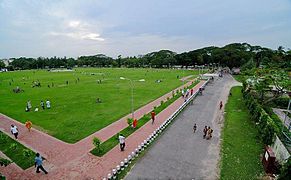
Bell's Park aka Bangabandhu Udyan
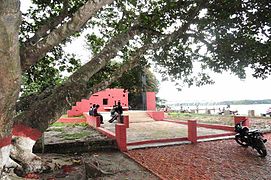
30 Godown Freedom Fighters Monument
Durgasagar: with an area of about 2,500 hectare, is the largest pond or dighi of southern Bangladesh. It is located at Madhabpasa village of babuganj upazila, about 11 km away from Barisal town. Locally it is known as Madhabpasha Dighi. According to a desire of Rani Durgavati, mother of Raja Joynarayan, the dighi was dug in 1780 (1187 BS). There are coconut trees around the dighi which together with the dighi are bounded by brick-walls. In the middle of the dighi, there is an island with bushes. Migratory birds usually come here during winter. The surrounding areas of the dighi has now been turned into a picnic spot.
Madhabpasha was a capital of the kingdom of Chandradvipa.
- Durga Sagar
- Baitul Aman Jame Masjid Complex
- Oxford Mission Church
Bell's Park aka Bangubandhu Udyan- 30 Godown
- Planet World
- Muktijoddha Park
- Narikel Bagan & Horticulture (Agriculture Training Institute)
- Lakhutia Zamindar Bari
- Korapur Miah Bari Masjid
- Shankar Math
- Town Hall
- Sher-e-Bangla Museum
- Bir Sreshtho Captain Mohiuddin Jahangir Library and Museum
- Jibanananda Das Museum
- Dapdapia Bridge
- Bibir Pukur[14][15]
- Shahid Shukkur-Gafur Memorial Park, Amanatganj
- Taltali Bridge, Amanatganj
- Padma Pukur (Pond of Lotus)
- Kali Mandir founded by the Poet Mukunda Das
- BadhyaBhumi Monument (বধ্যভূমি স্মৃতিসৌধ)
- Bangladesh Rice Research Institute Regional Centre (Coconut Garden)
Architecture
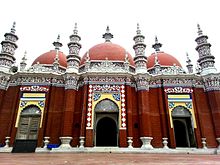
Miah Bari Mosque in Karapur, Barisal
Barisal's buildings are too diverse to be characterised by any particular architectural style, and have been built over a long period of time.
Some well known heritage buildings are:
- Guthia Baitul Aman Jame Mashjid Complex
- Rammohan Samadhi Mandir
- Sujabad Kella
- Sangram Kella
- Sharkal Fort
- Girja Mahalla
- Bangabondhu Uddyan
- Ebadullah Mosque
- Kasai Mosque
- Oxford Mission Church
- Shankar Math
- Kali Bari of Mukunda Das
- Joint Mosque at Bhatikhana
- Aswini kumar town hall
- Charkella
- Durgasagar Dighi
- One domed Mosque (Kasba)
- Fakir Bari jamee Mosjid
- Housing Estate Jame Mosjid
- Barisal Zilla School Building
Sports
Cricket and football are the two most popular sports in Barisal while tennis and kabaddi are also popular. There is a national stadium in the city known as Barisal Divisional Stadium (also known as Abdur Rab Serniabad Stadium). It is a multi-purpose stadium and has a capacity of 15,000 spectators. It is currently used mostly for cricket matches. It is also used for football and other sports. Besides different organization share to stage a show there occasionally. Notable players from Barisal who have played for the national team include Shahriar Nafees, Sohag Gazi, Kamrul Islam Rabbi and Fazle Mahmud.
There is a regional sports training center under Bangladesh Krira Shiksha Pratisthan (BKSP) situated at Rahamatpur in Barisal[16] Barisal is also home to the Bangladesh Premier League franchise Barisal Bulls.
Transport
Air
Barisal Airport is a domestic airport. Biman Bangladesh Airlines, Novoair and US-Bangla Airlines use this port. Active air-route is Barisal-Dhaka-Barisal.
River port
Barisal River Port is the second largest river port of Bangladesh. It's the most popular way of communication for the people of Barisal to Dhaka, the capital city. It is also a popular transport system with other districts like Bhola, Barguna, Lakshimipur.
Road
Barisal is connected to most other regions of the country via the N8 national highway. There are two bus terminals in Barisal, Nathullabad Central Bus terminal and Rupatali Bus Terminal. Many Bus company connect Barisal to other districts.
Education

Academic Buildings of the University of Barisal.
Barisal is home to many educational institutions. Govt. Brojomohan College is the oldest institution of higher education in the city, founded in 1889. There is a public university University of Barisal and two private universities, a government medical college Sher e Bangla Medical College (SBMC), a textile engineering college Shaheed Abdur Rab Serniabat Textile Engineering College and an engineering college Barisal Engineering College. There are also educational institutions like Barisal Zilla School, Barisal Cadet College, Govt. Syed Hatem Ali College, Government Women's College, Govt. Barisal College, Amrita Lal Dey College, Barisal Govt. Girls High School, Barisal Model School and College and Barisal Asmat Ali Khan Institution (A.K. School). Besides these there are three teacher training colleges, a Government Polytechnic institute, two technical institutes, a homeopathic college and a social welfare training centre. Barisal is under the Board of Intermediate and Secondary Education, Barisal. This board varies the SSC and HSC standard.
Major institutions include:
- Barisal Zilla School
- University of Barisal
- Sher e Bangla Medical College
- Brojomohun College
- Government Syed Hatem Ali College
- Barisal Government Women's College
- Amrita Lal Dey College
- Barisal Cadet College
- Shaheed Abdur Rab Serniabat Textile Engineering College
- Barisal Engineering College
- Barisal Govt. Polytechnic Institute
Culture
Media
Barisal is a center for the newspaper, periodical and book publishers. Some locally published newspapers and periodicals are:
Newspapers
- Daily Ajker Barta
- Daily Ajker Poribartan
- Daily Motobad
- Daily Shahnama
- Daily Banglar Bone
- Daily Dakkhinanchal
- Daily Barisal Pratidin
- Daily Barisal Barta
- Daily Satya Songbad
- Daily Bhorer Alo
- Daily Bhorer Angikar
- Daily Biplobi Bangladesh
- Daily Barisal er Ajkal
- Daily Ajker barisal
Source:[17]
Periodicals
- Bakerganj Parikrama
- Chirantan Bangla
- Upakul
- Gournadi Parikrama
- Khadem
- Jago Nare
Notable people
This section may be in need of reorganization to comply with Wikipedia's layout guidelines. (July 2018) (Learn how and when to remove this template message) |
A. K. Fazlul Huq, Bengali nationalist, politician, Prime Minister of Bengal and Governor of East Pakistan
Abdul Gaffar Chowdhury, Bangladeshi author, newspaper columnist and lyricist of Amar Bhaier Rokte Rangano
Altaf Mahmud, Bengali film song composer and one of the martyred intelligentsia in 1971
Kazi Golam Mahbub, Convener of the All Party State Language Action Committee during language movement- Major M. A. Jalil, commander of Sector 9 during Bangladesh War of Liberation in 1971
Mohiuddin Jahangir (Bir Shreshto) Bangladesh army captain during the 1971 Liberation War
Mostafa Kamal (Bir Shreshto), a freedom fighter
Mohammad Ali Bogra, also sometimes known as Mohammad Ali of Bogra, was a Bengali politician, statesman, and a career diplomat who served as third Prime Minister of Pakistan, appointed in this capacity in 1953 until he stepped down in 1955 in favor of Finance Minister Muhammad Ali.
Kusumkumari Das, poet, She is the mother of Jibanananda Das
Jibanananda Das, Bengali poet
Abu Zafar Obaidullah, poet, former agricultural minister of Bangladesh
Sufia Kamal, poet
Aroj Ali Matubbar, Philosopher
Abdur Rahman Biswas, former (11th) President of Bangladesh. Biswas represented Pakistan at the United Nations General Assembly prior to the independence of Bangladesh.
Anil Biswas, Hindi and Bengali film song composer
Kamini Roy, poet and first woman graduate with honours in the subcontinent.
Ahsan Habib, poet and literary figure in Bengali culture
Abul Hasan, poet, journalist and literary figure in Bengali culture
Narayan Gangopadhyay, poet, academic, writer
Hanif Sanket, TV presenter, entertainer, writer and producer
Dhirendra Nath Ganguly, early film directors
Nachiketa Chakraborty, Indian Bengali singer-songwriter and composer
Buddhadeb Guha, author
Srabanti Chatterjee, Srabanti Chatterje is a Bengali actress who appears in Indian films and has also appeared in variousBangladeshi films.
Sushmita Sen, Sushmita Sen is an Indian actress, model and beauty queen.
Aparajita Auddy, Indian actress involved in Bengali language film and television.
Jewel Aich, Bangladeshi magician
Mosharraf Karim, actor
Mir Sabbir, actor
Hasan Masood, Bangladeshi actor. He is also a former journalist and military officer.
Sohel Rana, Masud Parvez, is a Bangladeshi film actor, director and producer.
Tania Ahmed, actress
Golam Mustafa, film actor
Suborna Mustafa, actress
Manabendra Mukhopadhyay, singer and composer
Mithun Chakraborty, actor
Pannalal Ghosh, musician and flautist
Gurudas Dasgupta, member of the Indian Parliament and a leader of the Communist Party of India.
Nikhil Ghosh, was an Indian musician, teacher and writer, known his proficiency on the percussion instrument of tabla.[2] He founded Sangit Mahabharati.
Priya Ranjan Dasmunsi, ex-Minister of parliamentary affairs and information, India
Shamsuddin Abul Kalam, was an actor and an author of Bengali literature in Bangladesh.
Asad Chowdhury, poet, writer, translator, radio, television personality and journalist, as well as a cultural activist in Bangladesh.
Tofazzal Hossain Manik Miah, founding editor of The Daily Ittefaq
Utpal Dutt (29 March 1929 – 19 August 1993), actor, director and writer-playwright
Matsyendra, a saint and yogi from either Chandradwip (Barisal) or sandwip in Bengal
Arundhati Devi, actress
M Sakhawat Hossain, former Election Commissioner of Bangladesh (2007–2012) & brigadier general (retd) in Bangladesh Army
Rashed Khan Menon, politician
Abdul Jabbar Khan, Speaker of the National Assembly of Pakistan
Sadek Khan, Bangladeshi journalist, columnist and filmmaker
Selima Rahman, politician of Bangladesh Nationalist Party (BNP)
Rashed Khan Menon, Bangladeshi politician. He is the chairman of Workers Party of Bangladesh.
Amir Hossain Amu, Bangladeshi politician and senior leader in the Bangladesh Awami League.
Tofail Ahmed, Bangladeshi politician.
Anwar Hossain Manju, Bangladeshi politician.
Mainul Hosein, lawyer and the printer and publisher of daily newspaper The New Nation.
Kamal Hossain, Bangladeshi jurist, statesman and freedom fighter.
Delwar Hossain Sayeedi, Bangladeshi Islamic scholar, speaker and politician .
Narayan Gangopadhyay, Nalso known as Narayan Ganguly, was a Bengali novelist, poet, essayist, and short story writer.
Aruna Asaf Ali, born Aruna Ganguly, was an Indian independence activist. She was the first elected mayor of Delhi
Parul Ghosh, was an Indian playback singer . Ghosh sang in Hindi and Bengali movies from 1935 to 1951.
Arundhati Devi, was an Indian actress, director and writer who is predominantly known for her work in Bengali cinema.
Uttam Kumar, Indian film actor, director, producer, singer, composer, and playback singer who predominantly worked in Indian Cinema.
Golam Sarwar, journalist and Editor.
Ziauddin Ahmed (Bangladesh), war hero, freedom fighter and sub-sector commander under Sector 9 of Mukti Bahini during Bangladesh liberation war in 1971.
Shahjahan Omar, Bangladesh Nationalist Party politician and the former State Minister for law. He is retired Major of the Bangladesh Army and was awarded Bir Uttam. he was a sub-sector commander during Bangladesh liberation war in 1971.
Hafizuddin Ahmed, Bir Bikrom and Bangladesh Nationalist Party politician
Jahangir Kabir Nanak, Bangladesh Awami League politician and the former state Minister of Local Government, Rural Development and Co-operatives. He is the joint secretary of Bangladesh Awami League.
Naziur Rahman Manzur, was a Bangladesh Jatiya Party politician, founding chairman of the party, former government minister in the Cabinet of Hussain Mohammad Ershad and former Mayor of Dhaka.
Andaleeve Rahman, president of Bangladesh Jatiya Party, a member of Parliament, and the principal of British School of Law in Dhaka.
Khalid Hassan Milu, was a Bangladeshi singer.
Sudhir Ray, Indian politician. He was elected to the Lok Sabha, he was a member of the Communist Party of India (Marxist).
Manikuntala Sen, one of the first women active in the Communist Party of India, known for her Bengali-language memoir Shediner Kotha (published in English as In Search of Freedom: An Unfinished Journey).
Nikhil Sen, Bangladeshi dramatist. He was awarded Ekushey Padak in 2018 by the Government of Bangladesh.
Papia Sarwar, Bangladeshi singer. She is an exponent of Rabindra Sangeet. She earned Rabindra Award from Bangla Academy in 2013. She was awarded Bangla Academy Fellowship in 2015.
Abdul Jabbar Khan, was the 6th Speaker of the National Assembly of Pakistan. He was preceded by Fazlul Qadir Chaudhry.
A.Z.M. Enayetullah Khan, A.Z.M., was a veteran journalist, former minister of Bangladesh. He founded the weekly newspaper Holiday and the daily newspaper New Age. He served as the Minister from 1977 to 1978.
Sadek Khan, was a Bangladeshi journalist, columnist and filmmaker. In 2002, he was awarded Ekushey Padak by the Government of Bangladesh.
Selima Rahman, Bangladesh Nationalist Party politician. She served as a State Minister at the Ministry of Cultural Affairs of the Government of Bangladesh during 2001–2006.
Abdur Rab Serniabat, was a Bangladeshi Politician and former water resources minister. He was the brother-in-law of Sheikh Mujibur Rahman.
Abul Hasanat Abdullah, Bangladesh Awami League senior politician and a member of Parliament.
Mohiuddin Ahmed, was a Language Movement veteran and 1971 Liberation War organiser.
Abdul Karim Khan, famous folk-singer.
Jisshu Sengupta, Jisshu Sengupta, popularly known as Jisshu, is an Indian actor, producer and television presenter.
Science and academia
Abala Bose, educator and social reformer[18]
Swadesh Bose, language movement activist and economist[19]
Basudeb DasSarma, chemist[20]
Ashwini Kumar Dutta, educator and philanthropist[21]
Debaprasad Ghosh, mathematician and politician[citation needed]
Hiranmay Sen Gupta, nuclear physicist[22]
A. M. Harun-ar-Rashid, physicist and Bose Professor of Physics at the University of Dhaka
Ehsan Hoque, medical doctor, social entrepreneur and child rights activist. He is the founder and honorary Executive Director of Distressed Children & Infants International.
Fazlul Karim, was a scholar, academic, philosopher and essayist
Nazia Khanum, OBE, DL, Bangladeshi-born British management consultant, researcher, Director of Equality in Diversity, non-executive director for NHS Luton and chair of various voluntary community organisations
Ghulam Murshid, author, scholar and journalist, based on London
Amal Kumar Raychaudhuri, physicist
Hem Chandra Raychaudhuri, historian, known for his studies on ancient India
Tapan Raychaudhuri, historian
Kaliprasanna Vidyaratna, was an Indian scholar of Sanskrit, academician and author. He was the principal of the Sanskrit College between 1908 and 1910. Vidyaratna played an important role in the revival of Sanskrit language.
Sports and athletics
Sohag Gazi, cricketer[23]
Mehedi Hasan, cricketer[24]
Shahriar Nafees, cricketer[25]
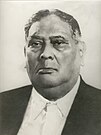
A K Fazlul Huq

Jibanananda Das
See also
- Barisal City Corporation
- Barisal District
- Barisal Division
References
^ "Barisal City Master Plan - Urban Development Directorate". Urban Development Directorate - Government of Bangladesh. Archived from the original on 14 April 2015. Retrieved 14 April 2015..mw-parser-output cite.citation{font-style:inherit}.mw-parser-output .citation q{quotes:"""""""'""'"}.mw-parser-output .citation .cs1-lock-free a{background:url("//upload.wikimedia.org/wikipedia/commons/thumb/6/65/Lock-green.svg/9px-Lock-green.svg.png")no-repeat;background-position:right .1em center}.mw-parser-output .citation .cs1-lock-limited a,.mw-parser-output .citation .cs1-lock-registration a{background:url("//upload.wikimedia.org/wikipedia/commons/thumb/d/d6/Lock-gray-alt-2.svg/9px-Lock-gray-alt-2.svg.png")no-repeat;background-position:right .1em center}.mw-parser-output .citation .cs1-lock-subscription a{background:url("//upload.wikimedia.org/wikipedia/commons/thumb/a/aa/Lock-red-alt-2.svg/9px-Lock-red-alt-2.svg.png")no-repeat;background-position:right .1em center}.mw-parser-output .cs1-subscription,.mw-parser-output .cs1-registration{color:#555}.mw-parser-output .cs1-subscription span,.mw-parser-output .cs1-registration span{border-bottom:1px dotted;cursor:help}.mw-parser-output .cs1-ws-icon a{background:url("//upload.wikimedia.org/wikipedia/commons/thumb/4/4c/Wikisource-logo.svg/12px-Wikisource-logo.svg.png")no-repeat;background-position:right .1em center}.mw-parser-output code.cs1-code{color:inherit;background:inherit;border:inherit;padding:inherit}.mw-parser-output .cs1-hidden-error{display:none;font-size:100%}.mw-parser-output .cs1-visible-error{font-size:100%}.mw-parser-output .cs1-maint{display:none;color:#33aa33;margin-left:0.3em}.mw-parser-output .cs1-subscription,.mw-parser-output .cs1-registration,.mw-parser-output .cs1-format{font-size:95%}.mw-parser-output .cs1-kern-left,.mw-parser-output .cs1-kern-wl-left{padding-left:0.2em}.mw-parser-output .cs1-kern-right,.mw-parser-output .cs1-kern-wl-right{padding-right:0.2em}
^ "Barisal City Corporation, Bangladesh" (PDF). ICLEI. Retrieved 12 April 2015.
^ ab "Population & Housing Census-2011" (PDF). Bangladesh Bureau of Statistics. p. 38. Archived from the original (PDF) on 8 December 2015. Retrieved 15 December 2015.
^ "Bangladesh changes English spellings of five districts". Bdnews24.com. Dhaka. 2 April 2018. Retrieved 2 April 2018.
^ Tapan Palit (2012). "Barisal City Corporation". In Sirajul Islam and Ahmed A. Jamal. Banglapedia: National Encyclopedia of Bangladesh (Second ed.). Asiatic Society of Bangladesh.
^ ab "Barisal City Corporation". Barisal City Corporation. Archived from the original on 2013-07-23. Retrieved 2014-09-19.
^ Ryley, J. Horton (1998). Ralph Fitch, England's pioneer to India and Burma : his companions and contemporaries ; with his remarkable narrative told in his own words (Reprint [der Ausg.] London, Fisher Unwin, 1899. ed.). New Delhi [u.a.]: Asian Educational Services. p. 118. ISBN 9788120613249.
^ "Our Cities: Beyond the Capital". 15th Anniversary Special. The Daily Star. 10 February 2006.
^ "Bangladesh Bureau of Statistics Region Census 2011 page 30" (PDF). Bangladesh Bureau of Statistics. Retrieved 2014-09-20.
^ ab "..:: Bangladesh Bureau of Statistics ::.. Region Census 2011 page 28" (PDF). Bangladesh Bureau of Statistics. Retrieved 2014-09-20.
^
"Climate of Bangladesh" (PDF). Bangladesh Meteorological Department. pp. 19–23. Archived from the original (PDF) on 24 December 2018. Retrieved 24 December 2018.
^
"Normal Monthly Rainy Day" (PDF). Bangladesh Meteorological Department. Archived from the original on 24 December 2018. Retrieved 24 December 2018.
^
"Normal Monthly Humidity" (PDF). Bangladesh Meteorological Department. Archived from the original on 24 December 2018. Retrieved 24 December 2018.
^ "Barisal Bibir Pukur needs attention". New Age. 30 June 2017. Retrieved 2018-11-23.
^ Ghosh, Sushanta (8 July 2017). "Bibir Pukur lies neglected". The Daily Star. Retrieved 2018-11-23.
^ "BKSP-Banglapedia". Retrieved 10 July 2014.
^ "পত্র-পত্রিকা" [Newspapers]. Barisal (in Bengali). Bangladesh National Portal.
^ Sen Gupta, D. P. (2009). Remembering Sir J.C. Bose. World Scientific. p. 16. ISBN 9789814271615.
^ Hossain, Urmee (2012). "Bose, Swadesh". In Islam, Sirajul; Jamal, Ahmed A. Banglapedia: National Encyclopedia of Bangladesh (Second ed.). Asiatic Society of Bangladesh.
^ Ainsworth, Susan J. (18 February 2008). "Obituaries". Chemical & Engineering News.
^ Khan, BR (2012). "Datta, Aswini Kumar". In Islam, Sirajul; Jamal, Ahmed A. Banglapedia: National Encyclopedia of Bangladesh (Second ed.). Asiatic Society of Bangladesh.
^ "Hiranmay Sen Gupta". Biographical Encyclopedia of Pakistan: 87. 1970. ISSN 0067-8732.
^ "Sohag Gazi". ESPNcricinfo.
^ "Mehidy Hasan". ESPNcricinfo.
^ "Shahriar Nafees". ESPNcricinfo.
External links
Wikisource has the text of the 1911 Encyclopædia Britannica article Barisal. |
- Official City of Barisal website
| Wikimedia Commons has media related to Barishal. |
Largest cities or towns in Bangladesh Population and Housing Census 2011[1] | |||||||||
|---|---|---|---|---|---|---|---|---|---|
| Rank | Name | Division | Pop. | Rank | Name | Division | Pop. | ||
 Dhaka  Chittagong | 1 | Dhaka | Dhaka | 8,906,039 | 11 | Savar | Dhaka | 296,851 | Khulna  Sylhet |
| 2 | Chittagong | Chittagong | 2,592,439 | 12 | Comilla | Chittagong | 296,010 | ||
| 3 | Khulna | Khulna | 664,728 | 13 | Narayanganj | Dhaka | 286,330 | ||
| 4 | Sylhet | Sylhet | 526,412 | 14 | Siddhirganj | Dhaka | 256,760 | ||
| 5 | Rajshahi | Rajshahi | 451,425 | 15 | Jessore | Khulna | 237,478 | ||
| 6 | Tongi | Dhaka | 406,420 | 16 | Cox's Bazar | Chittagong | 223,522 | ||
| 7 | Bogra | Rajshahi | 400,983 | 17 | Gazipur | Dhaka | 213,061 | ||
| 8 | Mymensingh | Mymensingh | 389,918 | 18 | Brahmanbaria | Chittagong | 193,814 | ||
| 9 | Barisal | Barisal | 339,308 | 19 | Dinajpur | Rangpur | 191,329 | ||
| 10 | Rangpur | Rangpur | 307,053 | 20 | Narsingdi | Dhaka | 185,128 | ||
Coordinates: 22°42′N 90°22′E / 22.700°N 90.367°E / 22.700; 90.367
^ Population and Housing Census 2011 - Volume 3: Urban Area Report (PDF), Bangladesh Bureau of Statistics, Aug 2014
